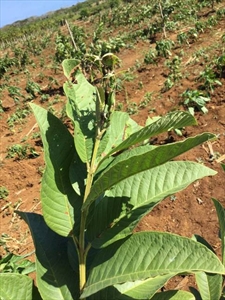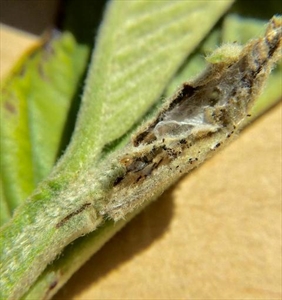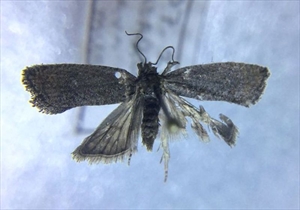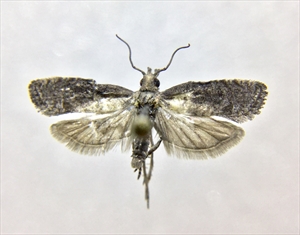Guava bud moth. Swaine (1971)1 refers to the moth as a 'webworm'.
Pacific Pests, Pathogens, Weeds & Pesticides - Online edition
Pacific Pests, Pathogens, Weeds & Pesticides
Guava bud moth (381)
Strepsicrates ejectana. It was previously known as Strepsicrates holotephras. However, there is some doubt whether these two species are the same based on male genitalia, which are used by taxonomists to differentiate between species of Strepsicrates. A revision of the genus is needed. The moth was first described from Fiji. It is a moth of the Tortricidae.
It is reported from Australia, New Zealand, the Philippines, and from the following Pacific islands: Fiji, French Polynesia, Northern Mariana Islands, and Samoa.
The larvae feed on
The caterpillars or larvae of the moth do the damage. Eggs are laid on young guava shoots (evidence from other species attacking guava, e.g., Strepsicrates smithiana). The larvae live in the rolled and webbed terminal leaves and their chewing causes yellowing of the leaves and eventually death of the shoot (Photos 1-3). When mature, the larva are 12 mm long, yellowish below and grey above. The head is yellowish-brown, the gut shows in places through the skin, and a U-shaped mark is present on the top of the last segment of the abdomen. The larvae also damage the young fruit by eating surface layers.
The pupae are about 8 mm long and develop in the webbed leaves.
The adult moth is 6 mm long with a wingspan is about 20 mm. The forewings are greyish brown with darker irregularly-shaped markings, and white speckling; the fringed hindwings are pale brown, with darker veins and borders (Photos 4&5).
There have been no investigations into the damage caused by this moth on cultivated guava in the Pacific, but on wild trees in Fiji, Swaine (1971) states: "At times, this is sufficiently numerous on guava to check its growth". It is very likely that similar damage occurs in plantations of cultivated varieties.
Look for rolled leaves, and the webs that hold them together. Unroll the leaves of the terminal shoots, and look for the larva or pupa, frass, webbing and extensive damage (and death) of the shoot.
NATURAL ENEMIES
None have been reported from Fiji, but it is likely that minute species of wasp parasitise the eggs or larvae of the guava bud moth.
CULTURAL CONTROL
Before planting:
- Inspect plants in the nursery and if rolled leaves are seen, kill the larvae inside by squeezing between finger and thumb, or if too numerous treat with a pesticide (see below).
During growth:
- In the field, routinely inspect the bushes, especially when the plants are young, and kill the larvae in rolled leaves or spray if infestations are large.
- Plant large blocks of flowering plants within and around guava plantations to attract parasitoids and to provide them with a source of nectar.
CHEMICAL CONTROL
- Use PDPs (botanicals) to safeguard natural enemies (chillies, neem, derris, pyrethrum), or microbial, commercial products, such as, spinosad, Bt (Bacillus thuringiensis subspecies kurstaki) sprays against caterpillars when young.
- In Florida, a number of insecticides have been registered for use on guava against a related species, Strepsicrates smithiana. Those recommended against lepidoptera (i.e., moth larvae) are: Bt (Bacillus thuringiensis), spinosad, pyrethrins (from pyrethrum or Chrysanthemum flowers), and malathion.
- In Australia, spinetoram (Success), carbaryl and the systemic dimethoate are registered for guava. Spot-spraying damaged shoots should be sufficient. Avoid 'blanket' spraying entire trees. To avoid killing natural enemies, if possible, avoid using malathion, carbaryl or dimethoate.
____________________
When using a pesticide, always wear protective clothing and follow the instructions on the product label, such as dosage, timing of application, and pre-harvest interval. Recommendations will vary with the crop and system of cultivation. Expert advice on the most appropriate pesticide to use should always be sought from local agricultural authorities.
AUTHORS Grahame Jackson & Mani Mua
1Swaine G (1971) Agricultural Zoology in Fiji. Her Majesty's Stationery Office. London. Information on the taxonomy of the moth from Todd Gilligan (see also Gilligan TM, Baixeras J, Brown JW (2018) T@RTS: Online World Catalogue of the Tortricidae (Ver. 4.0). (http://www.tortricid.net/catalogue.asp); and from Carillo D et al. (2017) Guava pests and beneficial insects. UF IFAS Extension, Florida. (https://edis.ifas.ufl.edu/ig072).
Produced with support from the Australian Centre for International Agricultural Research under project HORT/2016/185: Responding to emerging pest and disease threats to horticulture in the Pacific islands, implemented by the University of Queensland and the Pacific Community.








